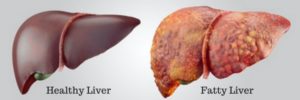
 One question many people ask is how long does it take to reverse and heal a fatty liver?
One question many people ask is how long does it take to reverse and heal a fatty liver?
Days, weeks, months?
The truth is that fatty liver is often caused by many years of poor diet and living in a toxic, stressed-out, chemical-filled environment.
Obviously, if that’s the case, you aren’t going to undo your damage overnight.
There are basically four grades of fatty liver:
Grade 1: Otherwise known as simple or Non-alcoholic fatty liver disease (NAFLD), this is what most people are diagnosed with. Grade 1 is where excess fat builds up within your liver cells, usually around 5% by weight. The good news is that NAFLD is almost always reversible.
Grade 2: Approximately 10% of all fatty liver cases progress to this level. It’s medically referred to as Nonalcoholic Steatohepatitis (NASH). If you are at Grade 2, it means there is already some scarring of your liver. The good news is that NASH is often reversible, but because of the scarring, your liver may never return to 100% functionality. That means you need to be very careful about what you eat, drink, and any toxins you are exposed to.
Grade 3: Over time, if left untreated, your fatty liver will eventually progress to Grade 3, which indicates serious issues, including low functionality, cirrhosis or fibrosis. At this point, you probably have multiple symptoms, including jaundice, abdominal pain, poor vision, weakness, and inflammation.
Grade 4: This is the point where the liver is beyond repair, and you may even need a liver transplant. Of course there are people who come back from this with good diet and a healthy lifestyle, but those cases are rare. Grade 4 is generally considered catastrophic since transplants are dangerous, expensive, and the long-term survival rate is quite low.

What’s The Recovery Time?
The recovery time is based on your level of damage, and how willing you are to abstain from alcohol, sugar, and processed foods while you are healing. The times below should be considered minimums…
- Recovery time for Grade 1: 3 – 6 months
- Recovery time for Grade 2: 6 – 12 months
- Recovery time for Grade 3: 1 – 2 years
- Recovery time for Grade 4: 2 – 3 years, possible liver transplant
Of course, if you continue to damage your liver with poor lifestyle habits, you may never fully recover. Your liver can rebuild itself, but you need to do your part.
Click here for a list of foods to avoid.



When you say to avoid most dairy products, does that include cultured dairy products such as plain homemade yogurt, keffir, etc. containing organic pasteurized milk & culture (only)?
That’s a great question. Dairy is generally not great for people who are in recovery for fatty liver. I recommend you take a break for 2 – 4 months.
Even organic milk contains saturated fat, natural sugars, and natural growth hormones, which is why it’s so great for baby cows. We know saturated fats are hard on the liver, and sugars (in this case lactose) can lead to bloating and digestive issues.
The natural growth hormones may or may not be in issue. Organic products should not have any added junk, but conventional products contain not only the naturally occurring hormones, they also contain added hormones, antibiotics, and the feed used may also contain pesticides and GMO corn, wheat, and other contaminated feed.
The problem isn’t GMO feed per se, but the lingering effects of glyphosate, which is used to grow GMO crops. You see, when you eat animal products, you are also eating everything they ever ate. Glyphosate has been directly implicated in fatty liver symptoms, at least in rats (https://www.nature.com/articles/srep39328).
With all that said, if you are not bothered by dairy (gas, bloating, abdominal pain), and you really do make your own products with organic milk, you can probably continue to enjoy them in moderation. Your homemade yogurts and kefirs are probably much better than the sugar and chemical laden crap available in the grocery store, and since you made it yourself, you know exactly what’s in there.
As an alternative, if you live in a warm climate and have access to fresh coconuts, try coconut kefir. I love it and while there is saturated fat in coconuts, it’s a healthier variety than in dairy, minus all the hormones and pesticides.
If I am not supposed to have tree nuts or anything processed such as pre-made processed foods which have been messed with then packaged then shipped then stored before making it to the grocer’s shelf, how can store-boughten almond milk be good for me at all?
And how do I make the “almond milk” for my steel cut oats without using tree nuts?
Are almonds and walnuts safe to use if I use Veggie Wash on the outside before shelling them?
I realize that peanuts–which are actually a bean, not a nut–are highly likely to be contaminated with that toxic mold from the soil in which the peanut shell grows. But I thought that real nuts, which grow on trees in protective shells were a healthy thing to eat because of all the nutrients they contain.
Are there any tree nuts that are safe to eat? I was supposed to eat a few walnuts or almonds every day because of their type of monounsaturated fat. But at the job I just left I was breathing toxic fumes from some rather nasty solvents I scrubbed with and I am suddenly showing signs of liver overload such as irritability, unaccountable joint pains and pain in the very tip of one finger, so I really want to make sure I eat properly for my liver just in case.
I’m glad you have these questions, because it means you are taking your health seriously. Let’s unpack what you asked, so we can deal with it logically.
First of all, the problem is not tree nuts specifically, it’s aflotoxins. Fresh tree nuts (like all fresh food) are not likely contaminated, at least not as much as corn or peanuts or cottonseed oil. Dr. Axe has a great article on aflotixins here:
https://draxe.com/aflatoxin/
The bottom line is to buy fresh nuts and use them quickly, within a few months. And also make sure you are properly nourished by eating detoxifying vegetables like carrots and celery. I don’t think washing the nuts does much, since the molds get inside during long, humid storage.
As far as almond milk being processed, it’s true that fresh almonds are going to be better for you that almond milk. But almond milk is going to be significantly better for you than regular milk because there are no hormones, saturated fats, or other issues with contaminated livestock feed.
Eating these days is really a matter of making smart choices, while at the same time being able to enjoy your food. A 1/4 cup of almond or soy milk (homemade or store bought) is fine on your steel cut oats. The volume is low, and for me at least, it makes the oats tastier and more filling. I also throw some (fresh) walnuts on there as well.
Also, I should probably mention that many people eat tree nuts, peanut butter, and other foods without an issue. For me, peanut butter was something I never considered, and when I stopped eating it, my liver stopped being inflamed.
I don’t actually care about peanut butter, but if I really did, I would probably find a different brand, or even grind my own and see if there is any change in my health. As crazy as it sounds, I think we all need to become biohackers by trying (or eliminating) different foods, and seeing how our health responds.
As far as your job, I’m glad you were able to leave it. I’ve had many jobs in my past where I worked around toxic or dangerous chemicals, and in most cases, the employer didn’t even have adequate safety gear. We all need to be our own health advocate these days.
unless the oats are organic, they likely contain glyphosate residue. Cheerios and Quaker Oats Old Fashioned Oatmeal (non-GMO Project) test at levels of glyphosate residues in excess of of 1500 parts per billion, even as high or higher than 2000 parts per billion. 1 part per billion even 1 part per trillion can cause endocrine disruption and cancer.
Definitely stick with organic.